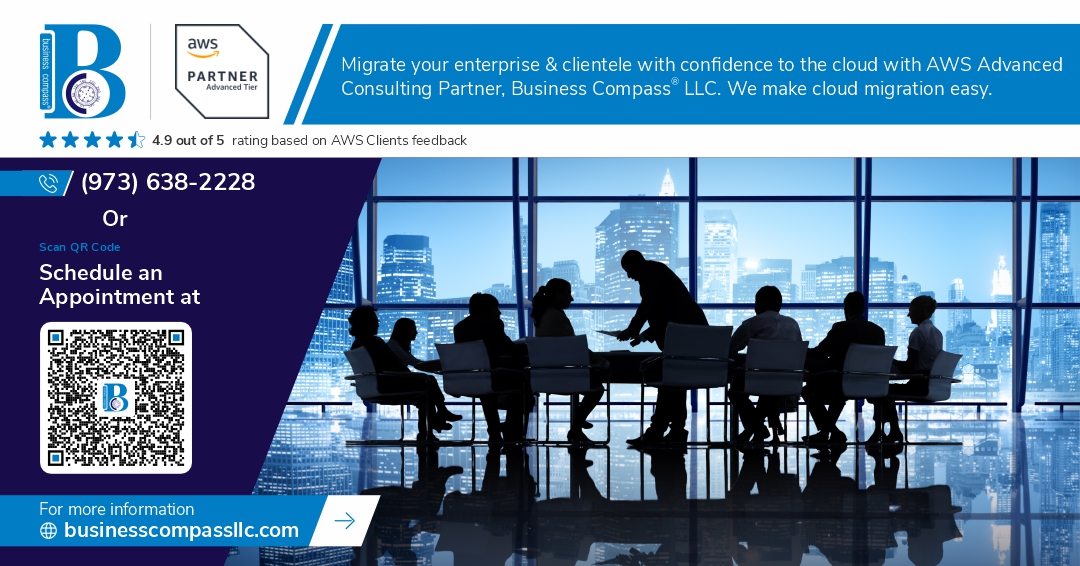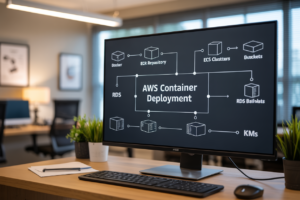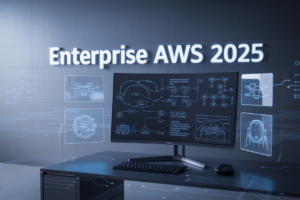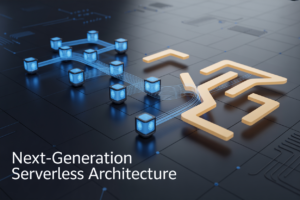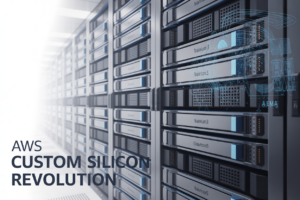🚀 In today’s cloud-driven world, businesses are constantly seeking ways to optimize their computing resources and streamline operations. But with so many options available, how do you know which Amazon Web Services (AWS) compute solution is right for your specific needs? Whether you’re a startup looking to scale quickly or an enterprise aiming to modernize your infrastructure, the choice can be overwhelming.
Enter the powerhouse lineup of AWS compute services: EC2, Lambda, Fargate, ECS, and EKS. These cutting-edge technologies are revolutionizing the way companies deploy and manage their applications. But what makes each of these services unique, and how can they solve real-world business challenges? In this post, we’ll dive deep into practical use cases that showcase the true potential of these AWS compute solutions, helping you make informed decisions for your organization’s cloud strategy.
From traditional virtual machines to serverless architectures and container orchestration, we’ll explore how businesses across various industries are leveraging these tools to drive innovation, reduce costs, and gain a competitive edge. Let’s embark on this journey through the AWS compute landscape, starting with the versatile Amazon EC2 and its game-changing applications in the real world. 💻☁️
Understanding Amazon EC2 Use Cases
A. Web Hosting and Application Servers
Amazon EC2 provides a robust platform for hosting websites and application servers, offering scalability and flexibility to meet varying workloads. Here’s how EC2 excels in this use case:
- Scalability: EC2 allows you to easily scale your resources up or down based on traffic demands.
- Cost-effectiveness: Pay only for the compute capacity you use, with various pricing options available.
- Customization: Choose from a wide range of instance types and configurations to match your specific requirements.
| Feature | Benefit |
|---|---|
| Auto Scaling | Automatically adjusts capacity to maintain steady performance |
| Elastic Load Balancing | Distributes incoming traffic across multiple instances |
| Amazon CloudFront | Improves content delivery speed with global CDN |
B. High-Performance Computing (HPC)
EC2 offers powerful instances designed for computationally intensive tasks:
- GPU-enabled instances for machine learning and graphics rendering
- High memory instances for large-scale simulations
- Clustered computing for parallel processing
C. Big Data Processing and Analytics
EC2 provides the necessary compute power for handling large datasets:
- Hadoop clusters: Run distributed processing frameworks like Hadoop on EC2
- Real-time analytics: Process streaming data using tools like Apache Kafka
- Data warehousing: Integrate with Amazon Redshift for complex queries
D. Gaming Servers
Game developers leverage EC2 for hosting multiplayer game servers:
- Low-latency gaming experiences with global infrastructure
- Burst capacity for handling player spikes during events
- Integration with other AWS services for game analytics and leaderboards
Now that we’ve explored EC2’s versatility, let’s move on to see how AWS Lambda enables serverless solutions for various use cases.
Leveraging AWS Lambda for Serverless Solutions
Real-time File Processing
AWS Lambda excels in real-time file processing, offering a scalable and cost-effective solution for handling incoming files. Here’s how Lambda can be leveraged for this use case:
- S3 Event Triggers: Lambda functions can be automatically triggered when files are uploaded to an S3 bucket.
- Image Processing: Resize, compress, or convert images on-the-fly.
- Data Transformation: Convert file formats or extract specific data from incoming files.
- Content Validation: Check file integrity and validate content against predefined rules.
| Feature | Benefit |
|---|---|
| Automatic Scaling | Handles varying file processing loads |
| Pay-per-use | Cost-effective for intermittent workloads |
| Low Latency | Near real-time processing of uploaded files |
| Easy Integration | Seamless connection with other AWS services |
Automated Backups and Scheduled Tasks
Lambda’s event-driven nature makes it perfect for automating backups and executing scheduled tasks:
- Database Backups: Trigger daily backups of RDS instances or DynamoDB tables.
- Log Rotation: Automatically archive and rotate log files on a set schedule.
- Data Synchronization: Keep data consistent across multiple systems or regions.
- Report Generation: Create and distribute periodic reports based on aggregated data.
Chatbots and Voice Assistants
Lambda functions serve as the brain behind intelligent chatbots and voice assistants:
- Natural Language Processing: Integrate with Amazon Comprehend for sentiment analysis and entity recognition.
- Dialog Management: Maintain conversation context and guide user interactions.
- API Integration: Connect to external services to fetch relevant information or perform actions.
- Multi-channel Support: Deploy the same logic across various platforms (Slack, Facebook Messenger, Alexa).
IoT Device Data Processing
Lambda is ideal for processing data from IoT devices due to its ability to handle concurrent executions:
- Data Filtering: Remove noise and irrelevant data from device streams.
- Anomaly Detection: Identify unusual patterns or readings from IoT sensors.
- Device Management: Update device configurations or firmware based on incoming data.
- Real-time Analytics: Perform quick calculations or aggregations on streaming IoT data.
API Backend Services
Lambda functions can power serverless API backends, offering scalability and reduced operational overhead:
- RESTful APIs: Create endpoints for CRUD operations using API Gateway and Lambda.
- GraphQL Resolvers: Implement flexible data fetching with AWS AppSync and Lambda.
- Microservices: Build modular, event-driven microservices architectures.
- Authentication and Authorization: Integrate with Amazon Cognito for secure API access.
With these diverse use cases, AWS Lambda demonstrates its versatility in building serverless solutions across various domains. Its event-driven nature and seamless integration with other AWS services make it a powerful tool for modern application development.
Optimizing Containerized Applications with AWS Fargate
Microservices Architecture
AWS Fargate excels in supporting microservices architectures, enabling organizations to build and deploy scalable, loosely coupled applications. By leveraging Fargate, developers can focus on writing code without worrying about underlying infrastructure management.
Benefits of Fargate for Microservices:
- Isolation: Each microservice runs in its own container
- Scalability: Independent scaling of individual services
- Resource Optimization: Precise allocation of CPU and memory
- Cost-Effectiveness: Pay only for resources used by each service
| Feature | Benefit |
|---|---|
| Serverless | No infrastructure management |
| Auto-scaling | Handles traffic spikes effortlessly |
| Integration | Seamless connection with other AWS services |
Batch Processing Jobs
Fargate is an excellent choice for running batch processing jobs, offering flexibility and cost-efficiency for tasks that don’t require constant runtime.
Fargate Batch Processing Use Cases:
- Data analysis and reporting
- Image and video processing
- Financial calculations
- Log file processing
CI/CD Pipelines
Integrating Fargate into CI/CD pipelines streamlines the development process, enabling teams to build, test, and deploy containerized applications more efficiently.
Fargate in CI/CD Workflow:
- Build: Package application into containers
- Test: Run automated tests in isolated environments
- Deploy: Push containers to production seamlessly
Scalable Web Applications
Fargate provides an ideal platform for hosting scalable web applications, offering automatic scaling and high availability without the complexity of managing servers.
Key Advantages:
- Auto-scaling based on traffic patterns
- Load balancing for optimal performance
- Integration with Amazon CloudFront for global content delivery
Now that we’ve explored Fargate’s capabilities in optimizing containerized applications, let’s examine how Amazon ECS orchestrates containers for even more complex scenarios.
Orchestrating Containers with Amazon ECS
Long-running Services and Applications
Amazon ECS excels at orchestrating long-running services and applications, providing a robust platform for continuous operation. Here are key advantages:
- High Availability: ECS ensures your services remain operational through automatic container replacements and load balancing.
- Scalability: Easily scale your applications up or down based on demand.
- Resource Efficiency: Optimize resource utilization across your container fleet.
| Feature | Benefit |
|---|---|
| Auto Scaling | Automatically adjusts capacity based on traffic |
| Service Discovery | Simplifies container-to-container communication |
| Integration with AWS Services | Seamless connection with RDS, S3, and more |
Scheduled Batch Jobs
ECS offers powerful capabilities for managing scheduled batch jobs:
- Precise Scheduling: Run jobs at specific times or intervals.
- Resource Allocation: Efficiently allocate resources for short-lived tasks.
- Job Prioritization: Manage job queues and priorities effectively.
Machine Learning Model Training and Deployment
ECS provides an ideal environment for ML workflows:
- GPU Support: Utilize GPU-enabled instances for intensive training tasks.
- Scalable Inference: Deploy models that can handle varying loads.
- Version Control: Easily manage different versions of your ML models.
Blue/Green Deployments
Implementing blue/green deployments with ECS offers several advantages:
- Zero Downtime: Switch between versions without service interruption.
- Easy Rollback: Quickly revert to the previous version if issues arise.
- Traffic Shifting: Gradually shift traffic to the new version for testing.
Now that we’ve explored ECS’s capabilities, let’s examine how Amazon EKS enhances Kubernetes management in the cloud.
Managing Kubernetes Clusters with Amazon EKS
Multi-cloud and Hybrid Cloud Deployments
Amazon EKS excels in managing multi-cloud and hybrid cloud deployments, offering a seamless experience across diverse environments. Organizations can leverage EKS to:
- Maintain consistency across on-premises and cloud infrastructures
- Distribute workloads for improved resilience and performance
- Comply with data sovereignty regulations by deploying in specific regions
| Deployment Type | Key Benefits |
|---|---|
| Multi-cloud | Avoid vendor lock-in, optimize costs |
| Hybrid cloud | Leverage existing infrastructure, gradual cloud adoption |
Stateful Applications and Databases
EKS provides robust support for stateful applications and databases, ensuring data persistence and consistency:
- Utilize persistent volumes for stateful workloads
- Implement StatefulSets for ordered, unique network identifiers
- Leverage EKS storage classes for dynamic provisioning
Auto-scaling Workloads
EKS enables efficient auto-scaling of workloads, optimizing resource utilization and cost:
- Horizontal Pod Autoscaler (HPA) for scaling pod replicas
- Cluster Autoscaler for adjusting node count
- Vertical Pod Autoscaler (VPA) for right-sizing resource requests
Edge Computing and IoT Platforms
Amazon EKS is well-suited for edge computing and IoT platforms, offering:
- EKS Anywhere for consistent Kubernetes deployments at the edge
- Integration with AWS IoT services for device management
- Support for GPU-accelerated workloads in edge locations
Big Data and Analytics Pipelines
EKS facilitates the deployment and management of big data and analytics pipelines:
- Run distributed processing frameworks like Apache Spark on EKS
- Deploy machine learning workflows using Kubeflow
- Integrate with AWS analytics services for comprehensive data processing
Now that we’ve explored the versatility of Amazon EKS in various scenarios, let’s examine how these AWS compute services work together to create comprehensive cloud solutions.
Amazon Web Services offers a diverse range of compute services, each designed to meet specific needs and use cases. From traditional virtual machines with EC2 to serverless computing with Lambda, and container orchestration with ECS, EKS, and Fargate, businesses have powerful tools at their disposal to build and scale applications efficiently.
Choosing the right compute service for your project depends on factors such as application architecture, scalability requirements, and operational preferences. By understanding the strengths and use cases of each service, you can make informed decisions to optimize your cloud infrastructure, reduce costs, and improve performance. Whether you’re running a simple web application or managing complex microservices, AWS’s compute offerings provide the flexibility and scalability needed to drive innovation and business growth in today’s digital landscape.










